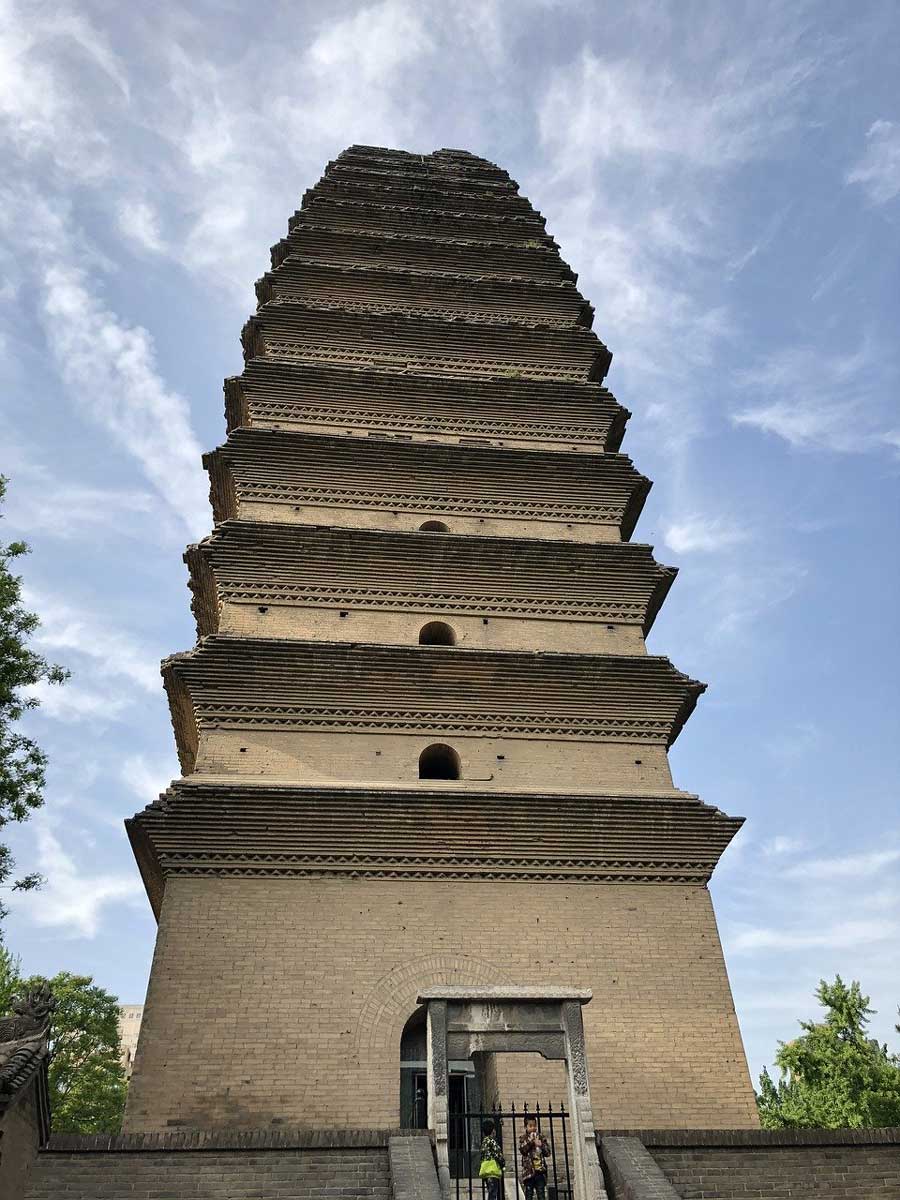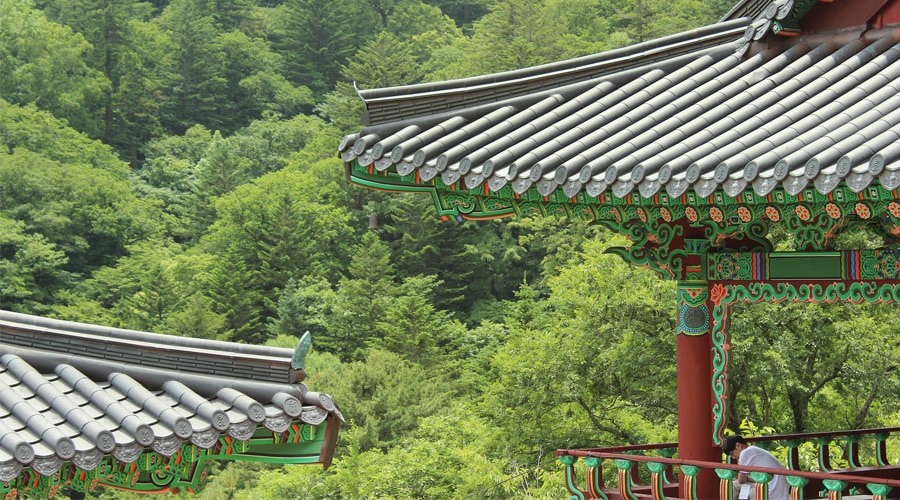If you ever found yourself in Xi’an (in Shaanxi Province), you’d better find the time to visit The Small Wild Goose Pagoda. Built during the Tang Dynasty (618-907), this pagoda is located in the south of the city on the central axis of the Jianfu Temple.
The name “Wild Goose” is used for two pagodas, The Small Wild Goose Pagoda and another one called “Giant Wild Goose Pagoda”. As the names suggest, The Small Wild Goose Pagoda is rather smaller than the Giant Wild Goose Pagoda, but it’s still a large building considering how old it is. The small pagoda is also more quiet and tranquil if you prefer a calmer environment. This pagoda is a remainder of Buddhist architecture during the Tang Dynasty. It shows how Buddhism came to China and how it integrated with the Han nationality culture. (Video Credit: LETSLOCALS)
Why It’s Called The Small Wild Goose Pagoda?
During the Tang dynasty and later Song Dynasty (960-1279), Small Wild Goose Pagoda was called “Jianfu Temple Pagoda”. The reason for choosing the new name was the existence of the “Giant Wild Goose Pagoda”.
“Wild Goose Pagoda” was constructed in the “Da Cien Temple” when Tang Emperor, Gaozong was reigning (during the Yonghui Period between 650 to 655). Its main purpose was to store and keep the Buddhist sutras brought by monk Xuan Zang from India to Changan (modern-day Xi’an).
The same thing happened during the Jinglong period (707-710) under the rule of Tang Emperor Zhongzong. Jianfu Temple Pagoda was constructed to serve the same purpose, but this time to store and keep the Buddhist sutras brought to China by monk Yi Jing.
The newer structure looked very similar to the “Wild Goose Pagoda” but it was smaller. So, the Jianfu Temple Pagoda was named Small Wild Goose Pagoda, and the Da Cien Temple Pagoda was named Giant Wild Goose Pagoda.
A Tall Standing Brick Tower
The Small Wild Goose Pagoda was constructed using blue bricks. First, it was a 15 story building with about 148 feet (45 meters) height. Due to many earthquakes and storms, the building suffered much damage during the time. These damages led to the destruction of the two highest stories. Today it is a 13 story structure with about 142.4 feet (43.4 meters) high.
The base of Pagoda is square-shaped and each side is 37.34 feet (11.38 meters). Underneath The Small Wild Goose Pagoda, an underground palace exists. Multi-eves of the building are made of overlapping bricks. There are two doors on the ground floor facing north and sound while on the other floors you can see windows.
This pagoda has a very beautiful design that looks like a very tall rectangular pyramid. The reason is that the measurements of each floor decrease as we gain altitude.
A Visit to The Top of Small Wild Goose Pagoda
If you want to go to the top of the pagoda, you will need to use the narrow stairway made of wood inside the pagoda. This stairway winds up all the way to the top but reaching the top is not easy. The ascend is not recommended for children, seniors, or people with a poor physical condition. Keep in mind that as you go higher, the stairway gets narrower and narrower, making it hard for larger people to continue.
When you reach the end of the stairway, you can find an open platform because the highest two stories were destroyed. It is a rather small area and only 10 people can fit there at the same time.
However, reaching the top of Small Wild Goose Pagoda can be quite a memorable experience. Imagine standing up there and getting an excellent view of the surrounding environment as well as a nice view of the ancient city of Xi’an in clear days. It’s really worth it if you can do it.
How it was magically healed after two earthquakes?
The first earthquake happened in 1487 which cracked the pagoda in the middle. The crack was more than 1.1 feet (0.33 meters). Then, another earthquake happened in 1521 and the crack was gone. Two parts of the tower miraculously were attached overnight.
This mystery was later revealed in 1949 after restorations. There was a reason why this pagoda could endure earthquakes and it lies in the wits of its builders. The pagoda took the shape of a hemisphere; therefore, it evenly distributed the stress and impact of the earthquake.
The pagoda has survived nearly 70 earthquakes. After all of these, The Small Wild Goose Pagoda still stands firm and sturdy. The result of marvelous workmanship by ancient builders is definitely admirable.

Morning Bell Chimes of the Small Wild Goose Pagoda
There is a very large iron bell in the temple, which has remained since 1192. It’s known as the “Magic Bell”. The bell is 11.6 feet (3.55 meters) in height, 8 feet (2.45 meters) in diameter, and 25 feet (7.65 meters) along the rim. Besides, it weighs around 17,636 pounds (8,000 kilograms).
The bell is carved with characters that interpret as follows:
Long live the Emperor;
The vassals help him forever;
May the State be stable and the people live in peace;
May the Buddhist principles prevail in the time to come.
The bell was struck by Buddhists and monks every morning. The sound of the bell is crisp but pleasant and it spreads as far as three miles (5 km). This is why “Morning Bell Chimes of the Pagoda” became famous and one of the eight famous scenic features in the Central Shaanxi Plain.
There is a belief that if you miss your beloved relatives who are far, you need to put their name and address on a yellow paper and struck the bell so they can receive the message. The original bell nowadays hangs in the bell tower near the Pagoda and there is a copy of it available for tourists to try.
Tourist Guide
[wpsm_colortable color=”main-color”]
| How to get to? | |
|---|---|
| By Bus | Bus No. 18, 21, 29, 32, 40, 46, 203, etc., as well as tourist bus line 7 & 8, can help you to reach Small Wild Goose Pagoda (Xiaoyanta) station |
| By Metro | Metro Line 2 helps you to reach Nanshaomen Station. You should leave the station here and walk west for about 6 minutes and find the north gate |
| Prices | |
| Ordinary days | Free for entering the pagoda |
| 1st – 15th of the 1st lunar month | 20 to 25 Yuan due to the temple fair |
| Ascending the pagoda | 30 Yuan |
| Opening Hours | |
| March 15-October 31 | 09:00-18:00 |
| November 1-March 14 | 09:00-17:30 |
| During the temple fair | Open until 21:00 |
| Closed | Every Tuesday with the exception of Chinese national holidays. |
[/wpsm_colortable]
Keep in mind that the last time you can buy a ticket in Small Wild Goose Pagoda ascending is an hour before the closing. Have you ever visited Xi’an and its pagodas? Feel free to share your comments and thoughts with us. Also, if you have any questions about the pagoda, feel free to leave them and our professional guides will reply as soon as possible.





